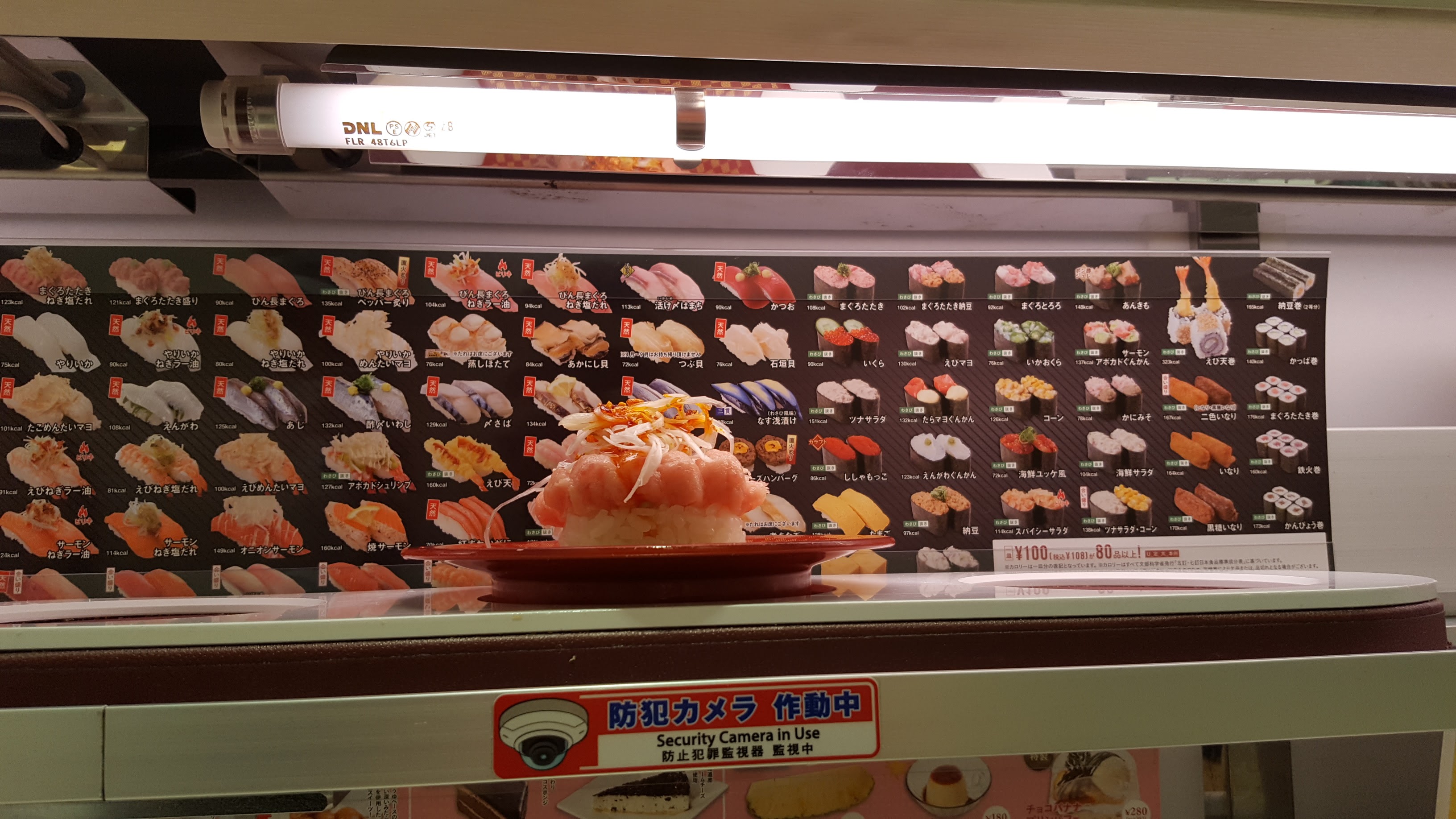
We visit the Uobei Sushi conveyor belt sushi restaurant and choose our top picks to save you time, money and potentially wasted calories.
Uobei Sushi – billed as “Presented by Genki Sushi,” the popular conveyor belt sushi chain – is a high-tech sushi shop located in downtown Shibuya that features a huge menu of mostly 100-yen (US$.96) items delivered directly to your seat by high-speed tracks affixed just above the counter. Eaters punch in their desired dishes on an electronic tablet and, a minute or so later, the food comes zooming out from the kitchen.
The process guarantees fresher sushi than your standard conveyor belt shop, since dishes are made to order and delivered directly. The shop’s freshness, convenience, novelty factor and English menu have made it a hit with foreigners and Japanese alike, but any grizzled sushi chain veteran knows that quality can vary widely by menu item at places like this. The cost-cutting measures low-price sushi chains have to take mean certain types of fish ought to be avoided since, let’s not kid ourselves here, the back of the house is more an assembly line than a collection of future Jiro Onos.
That’s why we dropped by Uobei Sushi to try a whole bunch of the restaurant’s menu offerings and give our top picks, so readers can get the most bang for their buck during their next visit. Here, presented in no particular order, are our top six Uobei Sushi plates, plus a few honorable mentions:
Tataki Ra-yu (Pounded tuna with spring onions and spicy sauce)
Tataki is a method of preparing raw fish by beating the living hell out of it with whatever blunt, heavy kitchen implement is available. The preparation turns this dish’s already melt-in-your-mouth tuna into a gorgeous, ruffled neta that seems to dissolve almost instantly, coating your palate in rich, buttery tuna goodness. The spring onion adds a pleasant crunch and the spicy ra-yu sauce brings just the right amount of bite.
Ikura Gunkan (Salmon roe)
Most sushi diners are familiar with the ikura salmon roe gunkan maki. Along with uni (sea urchin), it’s one of the top delicacies of the sushi world, but the extremely salty roe can be off-putting for many. Uobei Sushi adds a generous slice of cucumber to mellow the saltiness of the roe and deliver a satisfying crunch to the dish.
Kani-miso (Crab mustard)
Crab mustard – the mushy, steamed remains of the hepatopancreas, an organ found only in crabs and lobsters – is a delicacy many western eaters outside of, say, every single person in Maine, find hard to stomach. It’s got kind of a gross, grayish color, it’s slightly bitter, and has a mildly grainy texture. When served as gunkan maki sushi, it’s usually piled in an unappetizing, unwieldy mass, but Uobei keeps it to a tasteful dollop and brilliantly pairs it with a helping of crab meat, the sweetness of which perfectly balances the brininess of the mustard.
Bincho Pepper Aburi (Lightly roasted tuna)
It’s a fact of life that conveyor belt sushi vendors in Japan often try to mask the blandness of subpar sushi cuts with a huge spoonful of mayonnaise and a quick once-over with a kitchen blowtorch. The already fairly cloying Japanese mayonnaise becomes gag-inducingly sweet when cooked – especially in such large quantities – but Uobei Sushi’s bincho pepper aburi is the exception that proves the rule. The chefs in the back practice an amount of mayonnaise restraint we literally did not believe Japanese people were capable of, and the pepper adds a nice, piquant profile to take the cloying edge off the mayo.
Ebi Katsu-maki (Deep fried shrimp roll)
The guilty pleasure of our top six, the ebi katsu-maki is a sushi roll made with deep-fried shrimp and a slathering of tartar sauce. It’s akin to something you’d find in a western sushi shop, but it’s undeniably delicious and serves as a great palate cleanser between the fishier servings of classic Japanese nigiri options.
Engawa (Flatfish)
Flatfish is a particularly ugly marine animal that tends to go underappreciated in the sushi dining world. Cut from the “wings” of the fish, engawa is a thin slice served nigiri style. Uobei adds a little flair by tucking a portion of shiso leaf beneath the neta for a hint of earthy, tangy flavor that brings the dish to a new level. The meat of the flatfish is best described as a surprisingly good middle point between the fattiness of tuna and the chewy density of squid.
Honorable Mentions:
Kani korokke (Crab cream croquette)
Another guilty pleasure, this one takes an honorable mention for being sinfully delicious, but also for being a limited-run menu item that is categorically not sushi.
Ni-anago (Boiled conger eel)
Anago is a staple of highfalutin sushi courses and is objectively delicious. The anago we tried at Uobei was disappointingly dry, but anago is a lot like pizza in that even the worst you can get still tastes great.
Akanishi-kai (Rock shell)
We knew we needed a clam/mollusk entry and this one was the best. It’s nothing to write home about but was definitely tasty; just a little fatty with a unique chewy-slash-crunchy texture and just a hint of brine.
Shime-saba (Pickled mackerel)
This is a throwback to the historical style of making sushi, when fish were submerged in a vinegar solution to preserve them. It serves as a delicious final plate to round out your gluttonous sushi binge, with the tangy pickled mackerel washing the fatty umami of the previous dishes from your palate.
So those are our top picks for Uobei Sushi. A few might be hard to swallow for those who aren’t hardcore connoisseurs of all things raw fish, but give them a try and we promise you won’t be disappointed. And hey, at just 1,050 yen for the entire selection, you don’t have much to lose anyway.
Images © RocketNews24